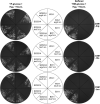Transformation of Candida albicans with a synthetic hygromycin B resistance gene
- PMID: 20737428
- PMCID: PMC4243612
- DOI: 10.1002/yea.1813
Transformation of Candida albicans with a synthetic hygromycin B resistance gene
Abstract
Synthetic genes that confer resistance to the antibiotic nourseothricin in the pathogenic fungus Candida albicans are available, but genes conferring resistance to other antibiotics are not. We found that multiple C. albicans strains were inhibited by hygromycin B, so we designed a 1026 bp gene (CaHygB) that encodes Escherichia coli hygromycin B phosphotransferase with C. albicans codons. CaHygB conferred hygromycin B resistance in C. albicans transformed with ars2-containing plasmids or single-copy integrating vectors. Since CaHygB did not confer nourseothricin resistance and since the nourseothricin resistance marker SAT-1 did not confer hygromycin B resistance, we reasoned that these two markers could be used for homologous gene disruptions in wild-type C. albicans. We used PCR to fuse CaHygB or SAT-1 to approximately 1 kb of 5' and 3' noncoding DNA from C. albicans ARG4, HIS1 and LEU2, and introduced the resulting amplicons into six wild-type C. albicans strains. Homologous targeting frequencies were approximately 50-70%, and disruption of ARG4, HIS1 and LEU2 alleles was verified by the respective transformants' inabilities to grow without arginine, histidine and leucine. CaHygB should be a useful tool for genetic manipulation of different C. albicans strains, including clinical isolates.
Copyright © 2010 John Wiley & Sons, Ltd.
Figures



References
-
- Amberg DC, Botstein D, Beasley EM. Precise gene disruption in Saccharomyces cerevisiae by double fusion polymerase chain reaction. Yeast. 1995;11(13):1275–1280. - PubMed
-
- Cannon RD, Jenkinson HF, Shepherd MG. Isolation and nucleotide sequence of an autonomously replicating sequence (ARS) element functional in Candida albicans and Saccharomyces cerevisiae. Mol Gen Genet. 1990;221(2):210–218. - PubMed
Publication types
MeSH terms
Substances
Grants and funding
LinkOut - more resources
Full Text Sources
Molecular Biology Databases
Research Materials
